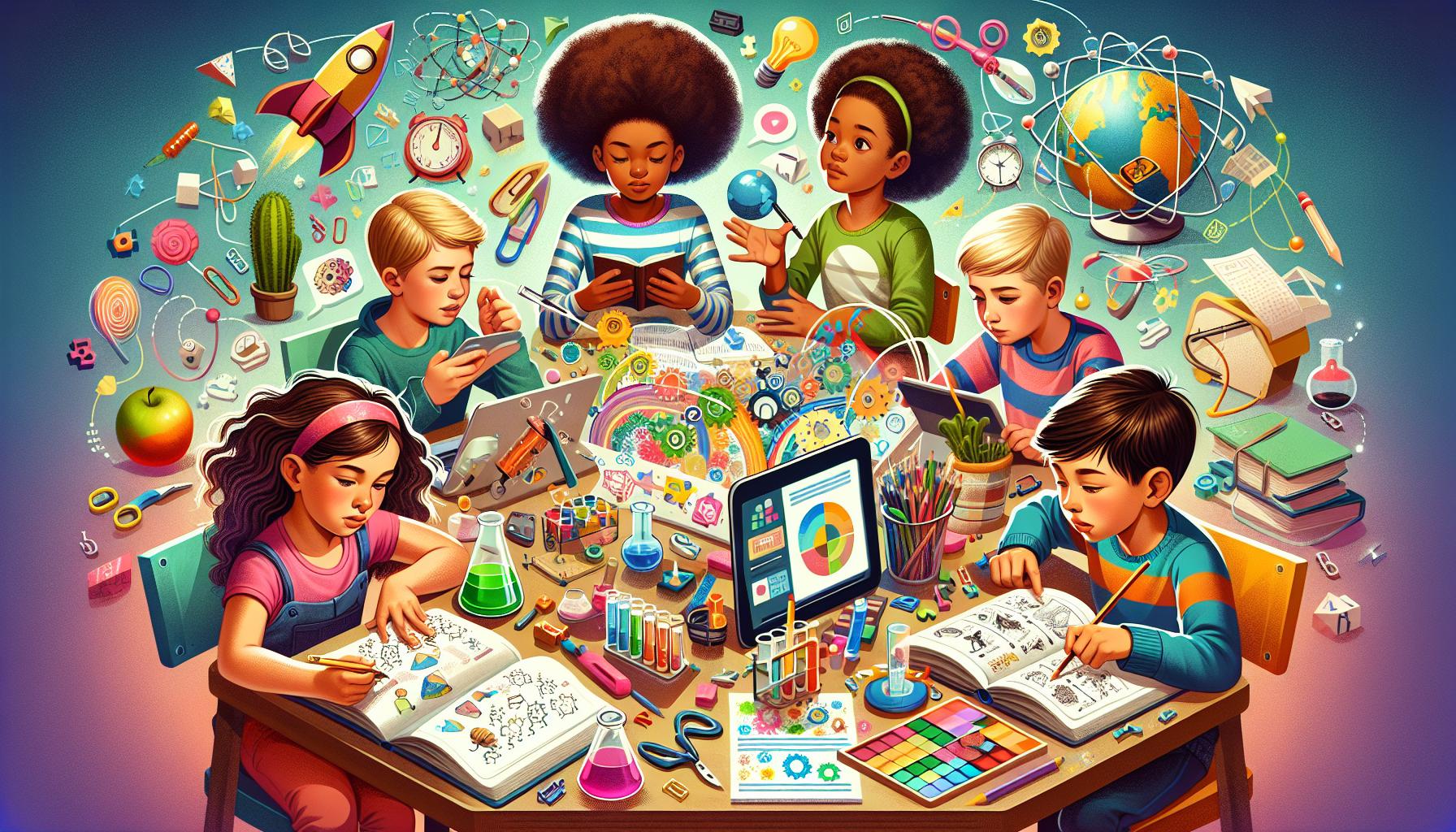
Key Takeaways
- Homeschooling resources provide structure, support, and flexibility to create an effective and engaging learning environment.
- Diverse tools, including online platforms, textbooks, curriculum packages, and educational games, cater to different learning styles and subject needs.
- Personalized resources allow parents to tailor lessons to their child’s unique pace and preferences, enhancing their learning experience.
- Both free and paid homeschooling resources offer valuable benefits, with free options being cost-effective and paid tools providing advanced features and comprehensive support.
- Parents can confidently teach and plan by using expert-designed materials, reducing stress while fostering creativity, critical thinking, and academic growth.
- Choosing resources aligned with your child’s learning style, educational goals, and family budget ensures a balanced and enjoyable homeschool experience.
Homeschooling opens up a world of opportunities, but it can also leave us wondering where to start. How do we find the right tools to support learning at home? What resources truly make a difference in creating an engaging and effective educational experience? These are questions many of us face as we take on the rewarding challenge of teaching our children ourselves.
Whether we’re new to homeschooling or looking to refresh our approach, having access to the right materials is key. From educational guides to interactive tools, the options can feel overwhelming. But with a bit of guidance, we can discover resources that fit our family’s needs and help create a learning environment where our kids can thrive.
Let’s explore how we can simplify this process and find practical, inspiring resources that make homeschooling not just manageable but enjoyable for everyone involved.
Benefits Of Using Homeschooling Resources
Homeschooling resources provide structure and support for parents and students. They help create a more organized learning environment by offering lesson plans, activity suggestions, and progress trackers. These tools simplify planning and save time, allowing families to focus on meaningful learning experiences.
Resources cater to diverse learning styles. Whether a child learns better visually, audibly, or through hands-on activities, specialized materials adapt to their needs. Examples include video tutorials, audiobooks, and science kits. These options make lessons more engaging and help children retain knowledge effectively.
Access to these resources builds confidence in teaching. Parents feel better equipped with accurate, up-to-date content and materials. They gain clarity on lesson objectives and how to teach them, reducing uncertainty or stress. This confidence positively influences both teaching and learning dynamics.
Homeschooling resources support personalized education. Every child’s learning pace is different, and tailored resources let parents adjust their approach. For instance, advanced worksheets can challenge a quick learner, while interactive apps might assist a child requiring extra reinforcement on a topic.
Many resources foster critical thinking and creativity. Educational games, project-based tools, and open-ended questions encourage students to explore concepts deeply. These methods go beyond rote memorization and prepare children to solve problems independently.
Pre-made resources provide access to expert knowledge. Research-backed curriculums and educational activities ensure students receive high-quality learning experiences. This reduces the burden on parents to create lessons from scratch and ensures better use of the available teaching time.
Communities and online platforms associated with homeschooling resources offer engagement opportunities. Parents can share tips, discuss challenges, and find encouragement from others going through similar experiences. These connections make the homeschooling journey less isolating and help families grow together educationally.
Types Of Homeschooling Resources

Homeschooling families have access to a wealth of resources that cater to different learning styles and educational goals. Understanding the available options helps create a balanced and engaging learning environment. Which resources resonate most with your family’s needs?
Online Platforms And Tools
Online platforms and tools provide flexibility and interactive learning experiences. These resources include virtual classes, video tutorials, and downloadable lesson plans. For example, many platforms offer subjects like math, science, or history through engaging multimedia content. Interactive exercises, such as quizzes and simulations, help reinforce lessons. Parents can track progress through built-in dashboards, making it easier to identify strengths and areas for improvement.
Textbooks And Workbooks
Textbooks and workbooks offer structured learning materials for various age groups. They cover core subjects like language arts, mathematics, and science while providing guided exercises to test comprehension. Many workbooks include answer keys, enabling parents to assess their child’s progress easily. For example, grammar-focused workbooks help refine writing skills, while science textbooks often include experiments to enhance hands-on learning.
Curriculum Packages
Curriculum packages combine lesson plans, teaching guides, and educational materials in one set. These packages are ideal for parents who prefer pre-planned schedules for the academic year. They often include detailed day-by-day plans, recommended reading lists, and assessments. Some packages cater to specific teaching philosophies, such as classical education or Montessori-based learning. They’re helpful for parents looking to save time on preparing lesson structures.
Educational Games And Activities
Educational games and activities add an element of fun to learning. Board games, flashcards, and science kits provide hands-on experiences that help kids retain information better. Activities like math puzzles, interactive story-building tools, and coding games make tough subjects enjoyable. They also encourage creativity and critical thinking, offering children an engaging way to apply concepts. Which types of games work best to spark your child’s curiosity?
How To Choose The Right Homeschooling Resources

Finding the best homeschooling resources requires understanding your child’s needs and your family’s priorities. Let’s explore key factors to make informed decisions.
Consider Your Child’s Learning Style
Every child learns differently, so it’s important to match resources to their preferred style. Do they excel with visual aids, like videos or diagrams? Are hands-on tools, such as science kits or art supplies, more engaging for them? Resources like interactive apps, audio lessons, or project-based activities can cater to auditory and kinesthetic learners. Reflect on how your child best retains information and explore options that align with their strengths.
Assess Your Educational Goals
Establish clear learning objectives to guide your selection process. Are you focusing on foundational subjects, such as math and language arts, or emphasizing specialized topics like coding or history? Think about short-term achievements—mastering multiplication or improving reading comprehension—and long-term aspirations, like preparing for high school or college-level studies. Choosing resources that align with these goals will help create a more focused and productive learning environment.
Budget-Friendly Options
Homeschooling doesn’t need to break the bank. Free or low-cost options, including library books, open educational resources, and printable worksheets, can provide high-quality content without stretching your budget. Subscription services, while often affordable, frequently offer access to extensive lessons, activities, or virtual classes. Consider combining free materials with occasional paid resources for a cost-effective and versatile approach to learning. How can you create a balance between affordability and quality in your homeschool plan?
Best Homeschooling Resources For Different Subjects
Selecting the right tools to teach specific subjects can make a significant difference in your homeschooling experience. Let’s explore resources for core subjects that cater to various learning styles and keep children engaged.
Language Arts
Language arts resources strengthen skills in reading, writing, and communication. Comprehensive programs with grammar exercises, vocabulary-building tools, and writing prompts offer structured support. For early learners, phonics-based tools introduce letter recognition and sound association. Interactive storytelling apps and reading platforms provide diverse literature, fostering a love for reading. Test preparation books and practice tools help older students enhance essay writing and comprehension skills. Which resource aligns best with your child’s language journey?
Math
Math resources simplify learning concepts through interactive activities and visual aids. Hands-on tools like fraction tiles and counters make abstract ideas more tangible. Online math platforms create personalized practice sessions for topics ranging from basic arithmetic to algebra. Printable worksheets, math games, and step-by-step video tutorials support learning at various paces. Consider resources that make math lessons feel accessible and fun. What helps your child connect with mathematical concepts most effectively?
Science
Science resources promote hands-on exploration and curiosity. Experiment kits allow children to investigate topics like chemistry, physics, and biology safely. Animated videos and virtual lab simulations simplify complex topics, offering visual explanations. Science encyclopedias, nature guides, and fieldwork tools encourage outdoor learning. Whether you’re working on ecosystems or experimenting with simple circuits, pick materials that make science an engaging adventure. What sparks your child’s interest in the natural world?
History And Social Studies
History and social studies resources cultivate understanding of past events, cultures, and global interconnections. Time-period-specific books, timelines, and geography maps provide context and visualization. Interactive documentaries and historical role-playing games help bring lessons to life. Civics workbooks and discussion guides build critical thinking about modern-day topics. Consider resources that develop a deeper appreciation for history and societal dynamics. How do you inspire discussions about culture and heritage in your lessons?
Free Vs Paid Homeschooling Resources
Finding the right homeschooling resources involves deciding between free and paid options. Both have distinct benefits and serve different purposes based on family priorities and budgets.
Free Homeschooling Resources
Free resources are widely accessible and cover various subjects. These include printable worksheets, educational websites, and public domain books. Online platforms often provide free video lessons, educational games, and practice quizzes. Community resources, like libraries, offer access to diverse educational materials without any cost. Parents looking to create a flexible learning plan can rely on these to supplement their curriculum. However, free resources might lack advanced features like progress tracking or personalized lesson plans.
Paid Homeschooling Resources
Paid options often include comprehensive curriculum packages, virtual classes, or premium tools. These resources typically offer structured programs with detailed lesson plans, interactive tools, and customer support. Paid subscriptions may provide access to advanced learning materials, such as science kits or digital lab simulations. While these can reduce planning time for parents, they come with a financial commitment. Considering educational needs and budget, families can assess whether the value added by paid resources justifies the cost.
What suits your family’s homeschooling approach better—customizable but simple free tools or professionally developed paid solutions? Balancing cost and quality helps maximize the benefits of any resource choice.
Conclusion
Homeschooling offers families a unique opportunity to tailor education to their children’s needs, and the right resources make all the difference. By exploring a variety of tools, from interactive platforms to hands-on materials, we can create an engaging and effective learning environment at home.
Whether we choose free or paid options, the key is to align resources with our goals, learning styles, and budget. With thoughtful planning and access to supportive communities, homeschooling becomes not just manageable but truly rewarding for both parents and students.
Frequently Asked Questions
What are the benefits of using homeschooling resources?
Homeschooling resources provide structure and support, making it easier to organize lesson plans, track progress, and tailor learning to your child’s needs. These tools enhance knowledge retention, encourage creativity, and build parents’ confidence in teaching. Many resources also offer expert-designed materials that simplify teaching and promote meaningful learning experiences.
How do I choose the right homeschooling resources?
To choose the right resources, consider your child’s learning style (visual, auditory, or kinesthetic), educational goals, and your budget. Look for tools that align with these factors, while ensuring they address core subjects and provide flexibility. Free and paid options can be combined to meet your needs affordably.
Are free homeschooling resources effective?
Yes, free resources like printable worksheets and educational websites can be effective for supplementing your curriculum. However, they may lack advanced features such as progress tracking or expert guidance, which are often included in paid packages. Evaluate your goals to determine whether free tools meet your needs.
What are the best tools for teaching core subjects?
For Language Arts, consider comprehensive programs with phonics tools and writing guides. In Math, use interactive apps and visual aids like hands-on manipulatives or workbooks. For Science, experiment kits and virtual lab simulations are ideal, while History can be taught with interactive documentaries and civics workbooks.
How can I make homeschooling more engaging for my child?
Incorporate educational games, project-based activities, and hands-on tools that align with your child’s interests. Multimedia content like videos and virtual classes can also enhance engagement. These resources make learning enjoyable while fostering creativity and critical thinking.
Should I invest in paid homeschooling resources?
Paid resources often include comprehensive programs, personalized support, and advanced features like progress tracking. If your budget allows, they can simplify planning and provide expert-quality materials. However, if affordability is a concern, free resources combined with affordable subscriptions can still create a balanced homeschooling experience.
Can homeschooling resources help with personalized learning?
Yes, homeschooling resources are ideal for personalized learning. They allow you to tailor lesson plans, adjust the pace according to your child’s needs, and use tools that suit their learning style. This customization promotes a more effective and enjoyable learning experience.
How do online platforms enhance homeschooling?
Online platforms offer flexibility, interactive lessons, and multimedia content. They often include virtual classes, progress tracking, and subject-specific tools. These platforms are especially useful for diverse learning styles, as they combine videos, quizzes, and hands-on activities in one accessible format.
What are budget-friendly options for homeschooling families?
Budget-friendly options include free printable worksheets, open educational websites, and library resources. Many affordable subscription services also provide quality materials without a large upfront investment. Combining free tools with low-cost paid resources helps balance affordability while maintaining educational quality.
How can I connect with other homeschooling families?
Join online communities, support groups, or local co-ops to connect with other homeschooling families. These groups provide opportunities to share tips, resources, and encouragement. Social networks and homeschooling forums are also great for building relationships and finding helpful guidance for your journey.

